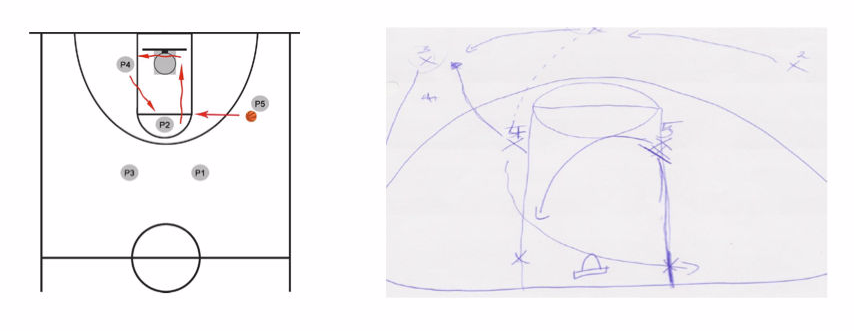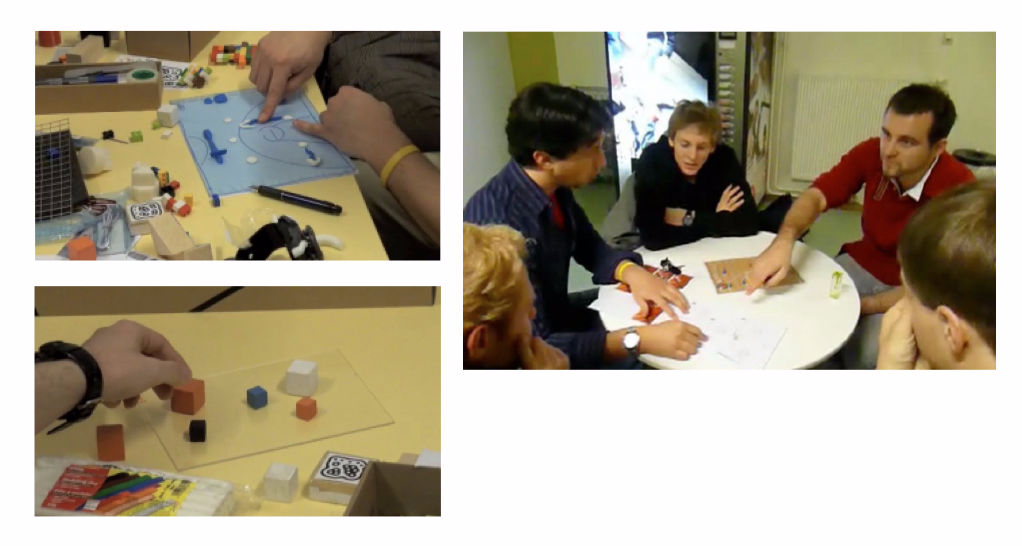
Analog sketch board

Batabo as "digital sketch board"
My role: UX designer, UX researcher, app developer
- Contextual interviews
- Cultural Probes
- Narrative Poster
- Design Game
- Scenarios
- Video prototypes
- Visual Basic for sketch board development
- Arduino, RFID tag for prototyping
- Helma, HTML, CSS, javaScript, mysql for website development
What is needed to ensure a shared understanding of basketball tactics?
What is needed to assist a basketball group in the administrative planning?
The basketball team is meeting on a regular basis 2-3 times a week. This depends if they have to prepare for a match or they have a regular training. Often players are working in companies or are studying. They meet each other also in their free time. They use a forum for organising training sessions.
During the design process, we have identified two topics for augmenting everyday activities of a Viennese basketball team, which resulted in two prototypes:
Sketchboard for game tactics: improves communication during and between training sessions and games

Analog sketch board

Batabo as "digital sketch board"
Administration portal for managing teams: solves time scheduling issues of sport teams

Study outcomes: The basketball team is currently using a forum for scheduling next training sessions. Often players are missing time changes, because they are not using the forum regularly. There is no connection with their personal calendars and no „plan b“, if the forum is offline.
Solution: Migo is a tool for improving administration of basketball groups. It is a platform for managing small sports teams and is built upon technologies like helma (used at ORF - Austrian Broadcasting Corporation), HTML, CSS, JavaScript and mysql.
In order meet the outcomes of our research studies, Migo has the following features and Use Cases:
A participatory design process was used, in order to understand the community and explore our ideas.
Design techniques were used to allow an open co-creation with basketball players as well as with the trainer.
Interviews, video observations and analysis
To understand the design frame, we have conducted expert interviews with the trainer as well as with players. The focus was on aspects during and between the games. Corporative work, team organizational questions as well as the usage of IT systems.
Outcomes: We have understood the current way how the team is working and how they share information regarding training sessions and matches. During the gameplay they are using a sketchboard. Usually the trainer is sketching new game tactics when there is a timeout.

Cultural Probes
We asked the basketball players to write down from their personal perspective, three most frequently used commandos that were used during the game. Each commando was written on a separate card. In this way, we gained an overview of the commonly used commandos during a game.
We asked every player to sketch the tactics on paper and discuss this with the team and with the trainer. In this way, we found that tactics were understood differently by the team.
Outcomes: The findings resulted in the fact that the same tactics during the training sessions and during the game can be differently structured and often have to be adapted to the current gameplay. Additionally, we found out that on each tactic some minor steps were missing. This brought us to setup a follow-up study (see "Design Game"), finding out how participants understand the steps of each tactic.


Design Game
A board game was created, that can be played with max. 5 players (like in a basketball game), focusing on the following questions:
- What strategies are the players using to memorize their tactics?
- How good do they know currently used tactics?
- Are the players sharing the same understanding?
Outcomes
There was more discussion about game moves than the actual gameplay, as the players had a different understanding of the game moves. The players are differently understanding each step of a tactic, which makes it complicated for the trainer, to communicate tactic adaptations for a specific gameplay.
The participants had fun by playing the game.
They liked the idea to learn new game moves in a playful manner.
They like the idea, that also new players can get into tactics very fast.
They found that there is a need to standardise the game moves, in order to have a shared understanding (as used in e.g. Playbook).

Narrative Poster
In order to communicate the design process to UX experts on the Technical University of Vienna, we used a narrative poster. A narrative poster contains of an overview of already used design methods as well as explains the idea generation phase and shows an overview of involved design techniques like cultural probes, design games, and video observation.
Outcomes: during the presentation of the poster, we have collected important aspects related to our initial ideas. For example, we found out that the sketchboard (Batabo) should be connected with the administration platform (Migo), in order to have a consolidated platform.

Prototyping
Based on our findings, we identified two ideas that could be integrated in the community. We have used scenarios to explain the ideas to the basketball team and to design experts form the Technical University of Vienna.
Batabo
Why: Based on the findings of "Cultural Probes" and "Design Game", we noticed that tactics were often misunderstood, especially details of each tactic like their specific steps are interpreted differently by each basketball player.
Also, just to mention, during video analysis of a training session, the trainer was holding the pen very carefully and in an uncomfortable position, in order not to scrawl over the ink on his pullover. This observation reinforced the need for a touchscreen solution for basketball tactics.
What: A digital sketchboard (Batabo) is designed to bring clarity to basketball tactics. It aims to make it easier for players to learn each step of a tactic during training sessions and to develop a consolidated understanding of the overall strategy. Additionally, the board should be flexible enough to adapt tactics during gameplay if needed.

Migo
Why: We had to cancel multiple observation sessions because not enough basketball players were signed up for the sessions. As the basketball team is using a forum for providing attendance information, this is not frequently used by the players as well as the players are often missing the sessions because the forum is not synchronized with their phone calendars.
What: Therefore, in the prototype "Migo", the idea is to communicate next training or game sessions and offer functionalities beyond a forum, like a newsfeed, private messages and game statistics.

Paper prototype

HTML prototype